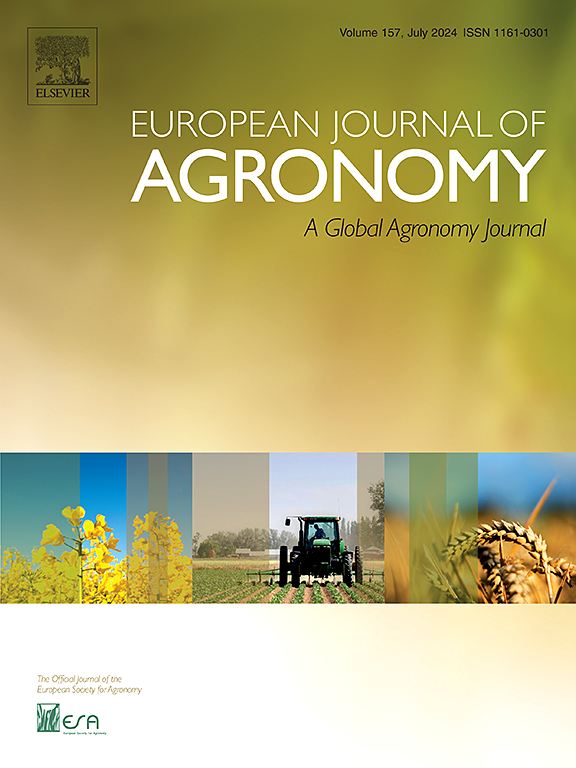Different utilisation of residual N from oil radish cover crop by maize or sugar beet, and subsequent winter wheat
IF 4.5
1区 农林科学
Q1 AGRONOMY
引用次数: 0
Abstract
Cover crops (CC) may take up substantial amounts of nitrogen and thereby reduce the soil nitrate pool in autumn and thus, the risk of nitrogen (N) leaching losses during winter. The dynamics of the remineralisation of this organic N into plant-available N pools affects the fertiliser N needs of subsequent crops and their economic optimal N rate (EONR). In a series of eight field trials (two years x four sites) across Germany, the effects of oil radish (OR) as CC on above-ground dry matter (DM) accumulation and N uptake of silage maize (SM) and sugar beets (SB) as first subsequent crops, and winter wheat (WW) as second subsequent crop were investigated in combination with four fertiliser N levels. Across all site-years, the N amount in pre-winter OR biomass clearly enhanced SM growth, while SB showed no or, in the unfertilized control, a negative response, indicating the occurrence of pre-emptive competition. The same pattern was observed for parameters derived from N response curves (DM yield and N uptake) without N fertilisation and at EONR. Net soil N mineralisation was stronger affected by soil type than by the first succeeding main crop with negative correlation of OR N uptake on sand and positive correlation on loess soils. In the second year, OR biomass N showed small effects on WW yield and N uptake without N fertilisation (positive after SM, negative after SB), but optimal N supply superimposed all OR effects. Residual N from OR did not significantly reduce EONR either in the first or the second succeeding main crop. For an economically beneficial effect in SM, OR N uptake must be at least 71 kg N ha−1, while in SB typical N uptake from CC would not reach the break-even point.
玉米、甜菜及后续冬小麦对油萝卜覆盖作物残氮利用的差异
覆盖作物(CC)可能会吸收大量的氮,从而减少秋季土壤硝酸盐库,从而增加冬季氮淋失的风险。有机氮再矿化进入植物有效氮库的动态影响了后续作物对肥料氮的需求及其经济最优氮肥率(EONR)。在德国各地进行的8个系列田间试验(2年× 4个站点)中,研究了油萝卜(OR)作为CC对青贮玉米(SM)和甜菜(SB)作为第一后继作物,冬小麦(WW)作为第二后继作物的地上干物质(DM)积累和氮吸收的影响。在所有样地年,冬前OR生物量的N含量明显促进了SM的生长,而在未施肥的对照中,SB没有或负响应,表明发生了先发制人的竞争。在不施氮和EONR条件下,从N响应曲线(DM产量和N吸收量)得出的参数也观察到相同的模式。土壤类型对土壤净氮矿化的影响大于第一次生主要作物对土壤净氮矿化的影响,沙地土壤净氮矿化与土壤净氮矿化负相关,黄土土壤净氮矿化与土壤净氮矿化正相关。第二年,未施氮肥的OR生物量N对WW产量和氮素吸收的影响较小(SM后为正,SB后为负),但最佳N供应叠加了所有OR效应。在第一茬和第二茬主作物中,OR的剩余氮没有显著降低EONR。为了在SM中获得经济效益,OR N的吸收量必须至少为71 kg N ha - 1,而在SB中,CC的典型N吸收量不会达到收支平衡点。
本文章由计算机程序翻译,如有差异,请以英文原文为准。
求助全文
约1分钟内获得全文
求助全文
来源期刊

European Journal of Agronomy
农林科学-农艺学
CiteScore
8.30
自引率
7.70%
发文量
187
审稿时长
4.5 months
期刊介绍:
The European Journal of Agronomy, the official journal of the European Society for Agronomy, publishes original research papers reporting experimental and theoretical contributions to field-based agronomy and crop science. The journal will consider research at the field level for agricultural, horticultural and tree crops, that uses comprehensive and explanatory approaches. The EJA covers the following topics:
crop physiology
crop production and management including irrigation, fertilization and soil management
agroclimatology and modelling
plant-soil relationships
crop quality and post-harvest physiology
farming and cropping systems
agroecosystems and the environment
crop-weed interactions and management
organic farming
horticultural crops
papers from the European Society for Agronomy bi-annual meetings
In determining the suitability of submitted articles for publication, particular scrutiny is placed on the degree of novelty and significance of the research and the extent to which it adds to existing knowledge in agronomy.
 求助内容:
求助内容: 应助结果提醒方式:
应助结果提醒方式:


